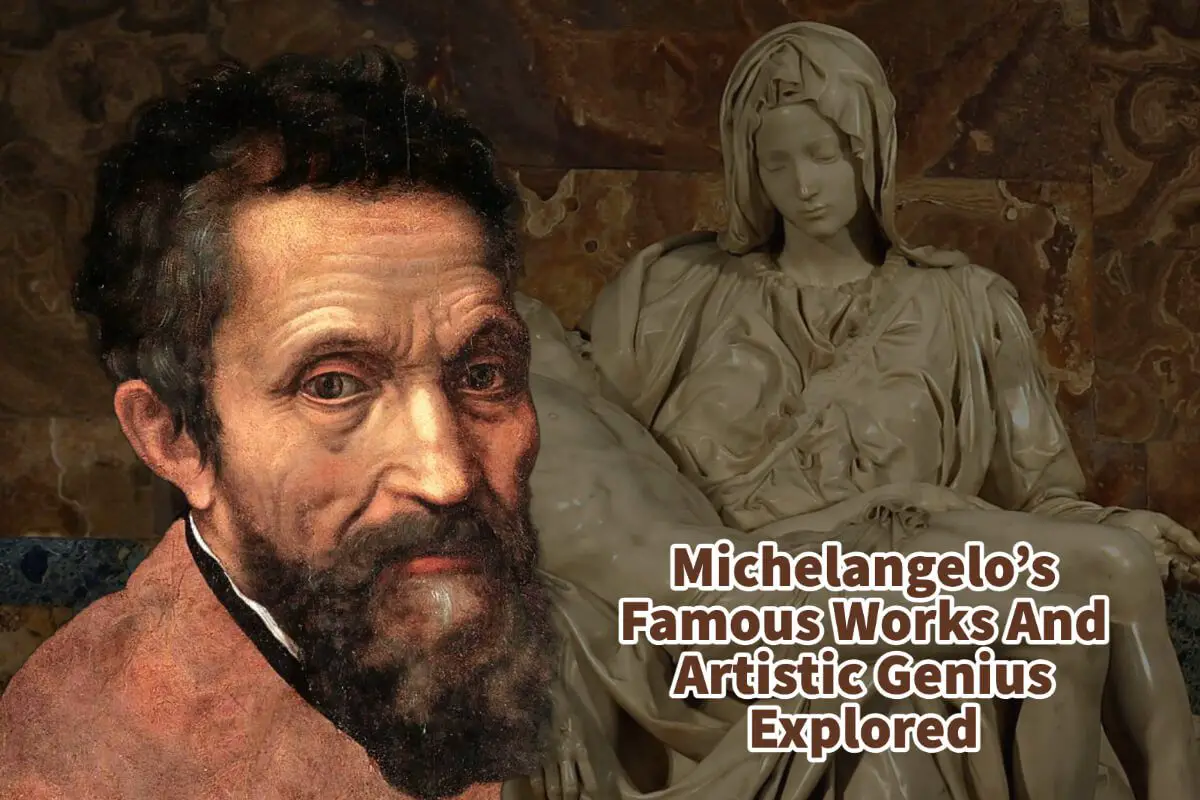Michelangelo undoubtedly stands as a monumental figure in the rich tapestry of art history. He is one of the greatest artists that ever lived.
Michelangelo’s exceptional skill, deep passion, and innovative foresight have etched his name as a genuine giant in art. Emerging during the Renaissance—a time of significant cultural and intellectual revival—Michelangelo’s contributions capture the very essence of that transformative period.
Table of Contents
- Michelangelo: The Genius And His Most Renowned Works
- Michelangelo: The Timeless Luminary of Art
- Frequently Asked Questions
- Related Questions
Michelangelo: The Genius And His Most Renowned Works
Michelangelo di Lodovico Buonarroti Simoni, commonly known as Michelangelo, was not only a prominent sculptor of the Renaissance era but also an accomplished painter, architect, and poet.
Born in the small village of Caprese in 1475, he grew up to become one of the most admired and celebrated artists in history. His unparalleled mastery over sculpting, particularly in depicting the human body, has made his name synonymous with the Renaissance movement.

Michelangelo’s life and career spanned almost nine decades, during which he produced an array of masterpieces, many of which are considered among the most famous artworks of Western art. These works, marked by their grandeur, deep emotions, and meticulous details, have captivated audiences for centuries.
In this post, we’ll delve into ten of Michelangelo’s most renowned works of art, revealing the genius behind each creation.
David (1501-1504)
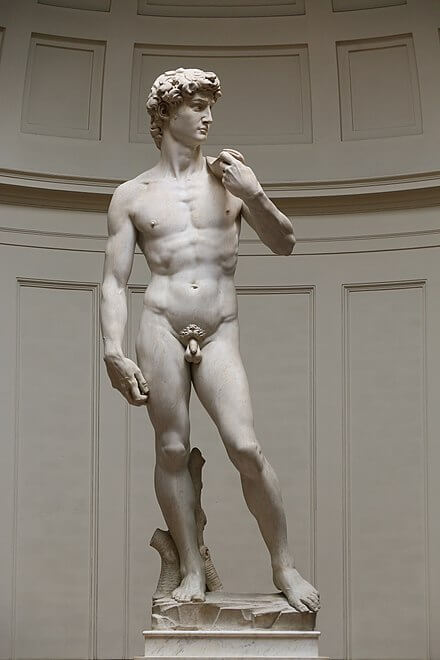
Sculpted when Michelangelo was just in his twenties, the statue of David represents the biblical hero who defeated the giant Goliath with a single stone. Carved from a single block of marble, this statue stands at an impressive height of 17 feet.
Situated in the Galleria dell’Accademia in Florence, ‘David’ is not just a symbol of Renaissance art but also of the strength and youthful beauty of humanity.
The Sistine Chapel Ceiling (1508-1512)
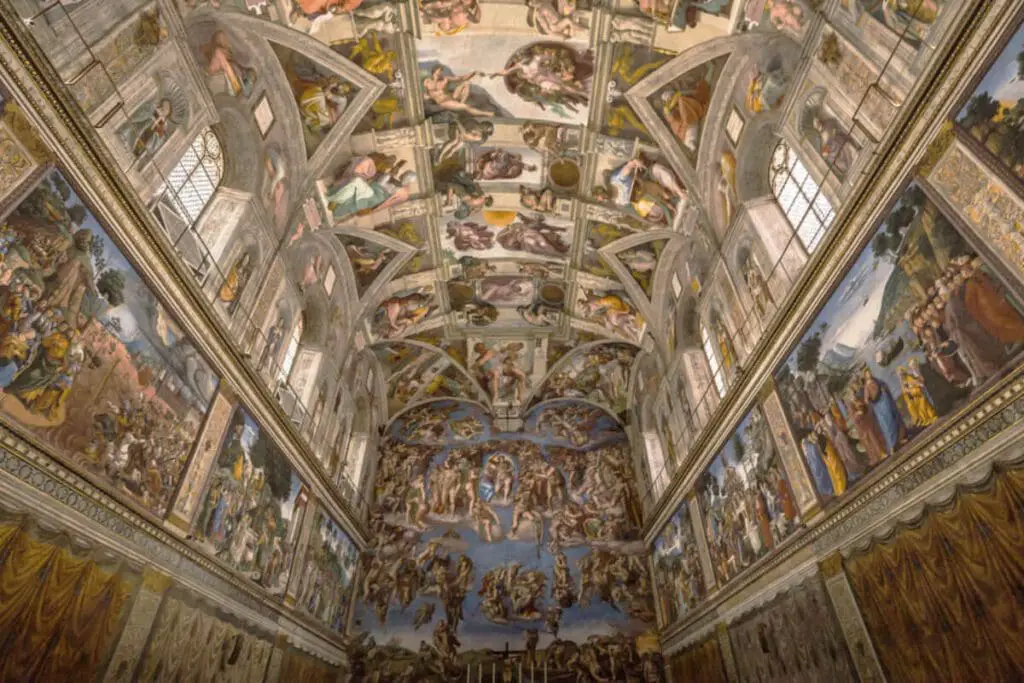
Commissioned by Pope Julius II, Michelangelo’s frescoes on the ceiling of the Sistine Chapel in Vatican City are nothing short of awe-inspiring. The central narrative depicts scenes from the Book of Genesis, including the famous ‘Creation of Adam,’ where God gives life to the first human. Every inch of the vast ceiling demonstrates Michelangelo’s mastery over the human form and his profound understanding of the Bible.
The Last Judgment (1536-1541)
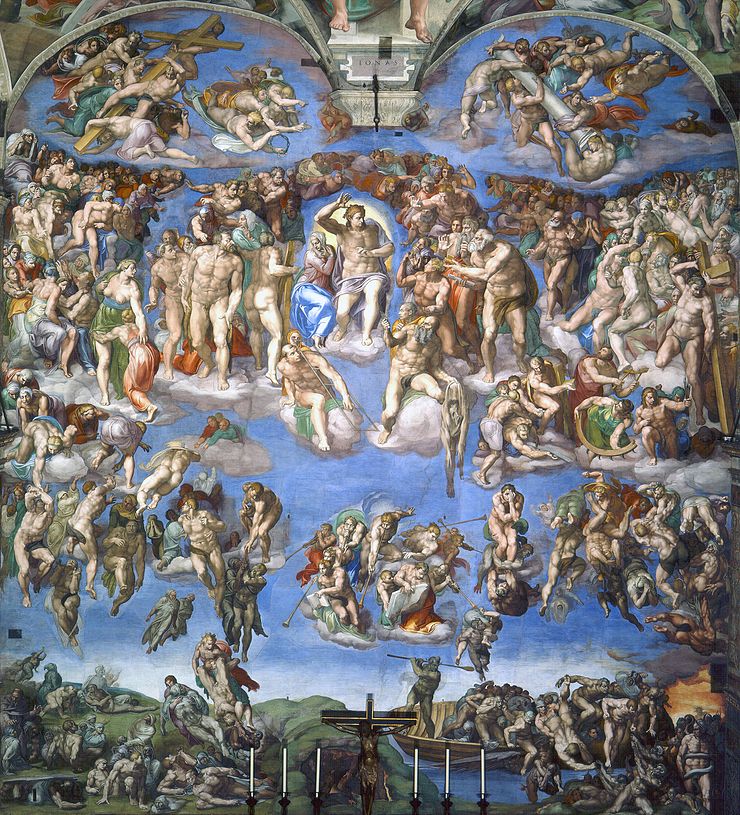
Another masterpiece in the Sistine Chapel, “The Last Judgment,” is painted on the altar wall. This dramatic and vivid portrayal of the Second Coming of Christ and the final judgment of souls is teeming with figures and detailed scenes from Christian eschatology.
The composition is chaotic, intense, and an exemplary display of Michelangelo’s maturity as a painter.
Pietà (1498-1499)

Housed in St. Peter’s Basilica in Vatican City, Pietà is a heart-wrenching sculpture showcasing the Virgin Mary cradling the dead body of Jesus Christ after his crucifixion. Michelangelo was only 24 when he created this work. Yet, he captured the moment’s profound sorrow and delicate beauty, making Pietà one of the most revered sculptures in the Christian world.
Moses (1513-1515)

This larger-than-life sculpture is part of the tomb of Pope Julius II, located in San Pietro in Vincoli, Rome. The figure of Moses, complete with the two tablets of the Ten Commandments and the horns on his head, exudes authority and vigor.
Michelangelo’s mastery of depicting intricate details, like the veins and muscles, makes the statue look incredibly lifelike.
The Medici Chapel (1520-1534)
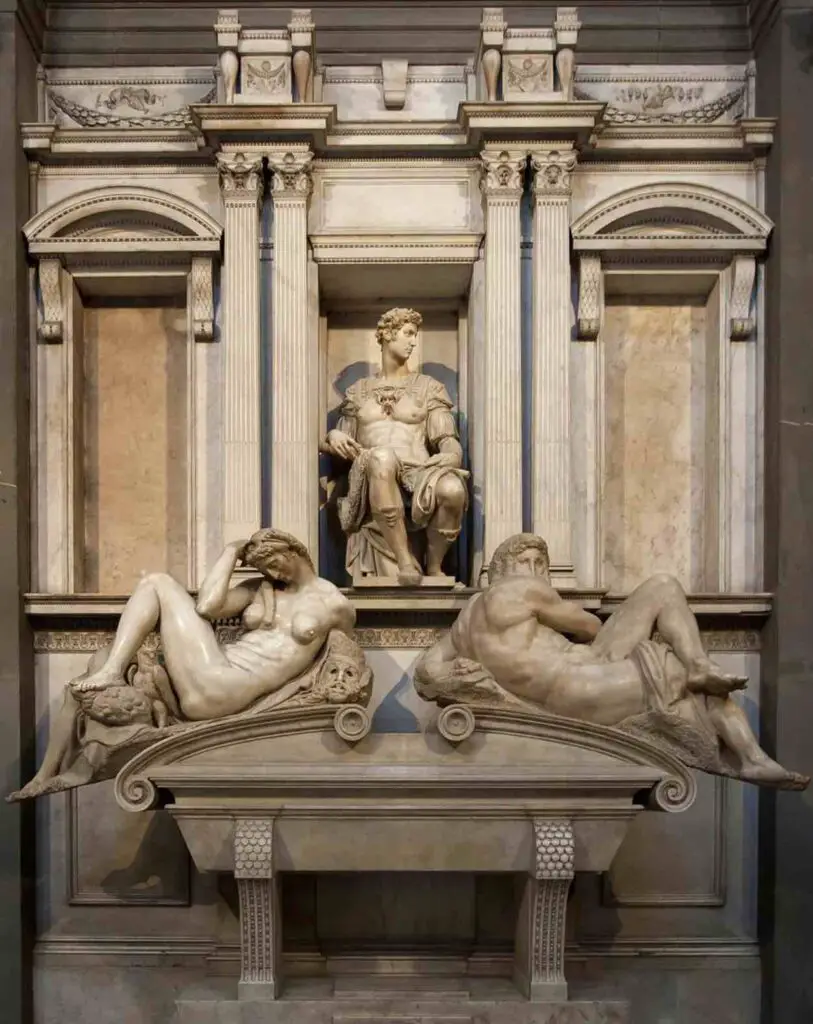
Commissioned by the influential Medici family in Florence, this chapel in the Basilica of San Lorenzo is a testament to Michelangelo’s architectural skills. The tomb sculptures, including “Dusk and Dawn” and “Day and Night,” are allegories that reflect the passage of time and the inevitability of death.
The Battle of the Centaurs (1492)
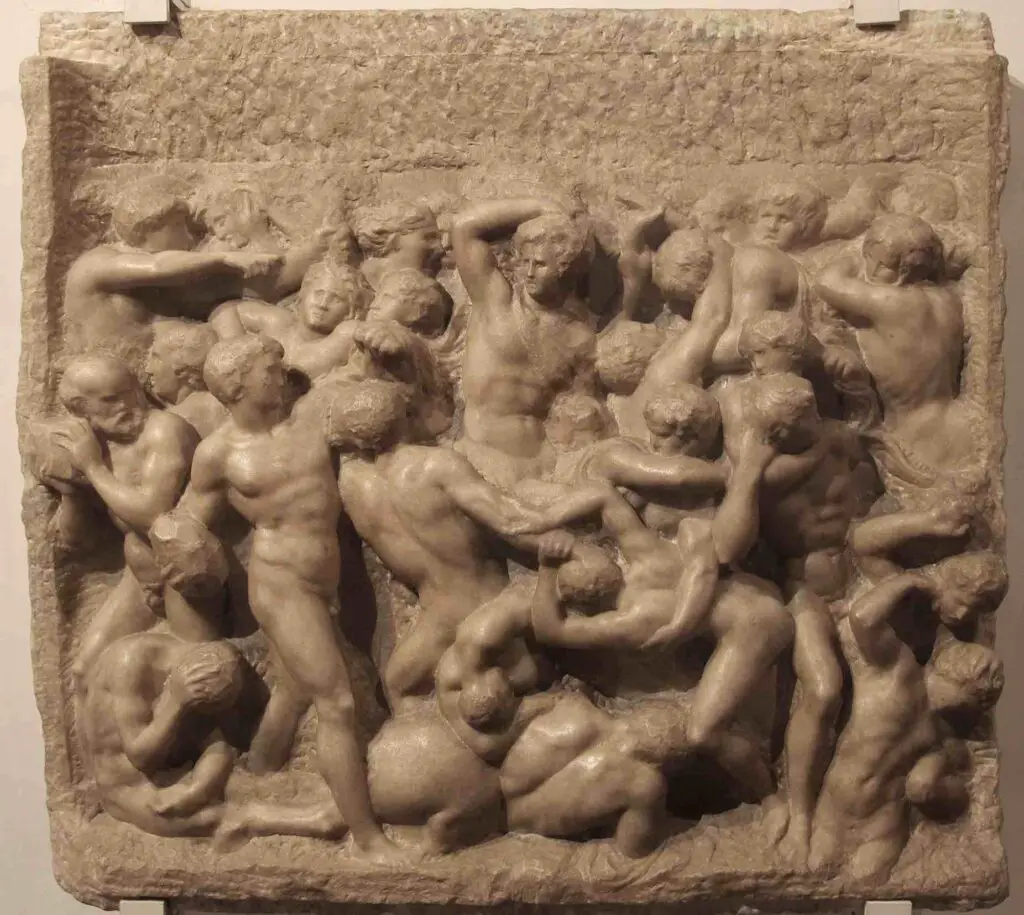
Crafted when Michelangelo was a teenager, this marble relief showcases Greek mythology’s battle between Lapiths and Centaurs. Even at this young age, Michelangelo’s ability to capture intense movement and emotion in stone was evident.
The Crucifix (1492)
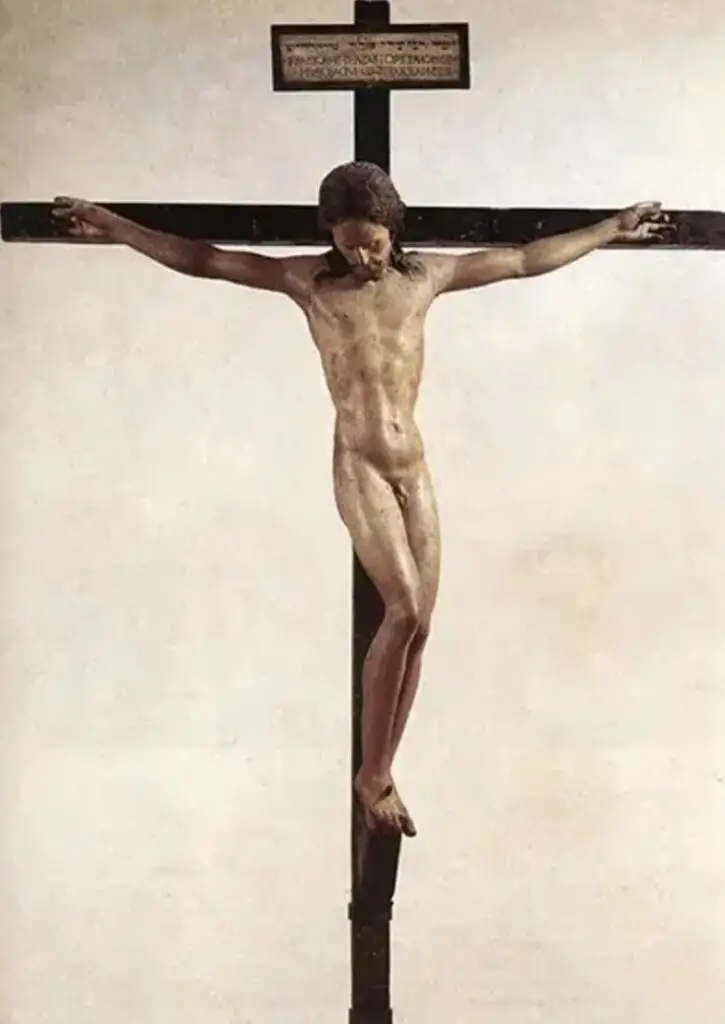
Located in the Santo Spirito Basilica in Florence, this wooden sculpture of Christ on the cross showcases Michelangelo’s deep understanding of the human anatomy. Created when he was only 18, the Crucifix reflects his early experimentation with form and structure.
The Laurentian Library (1524-1559)
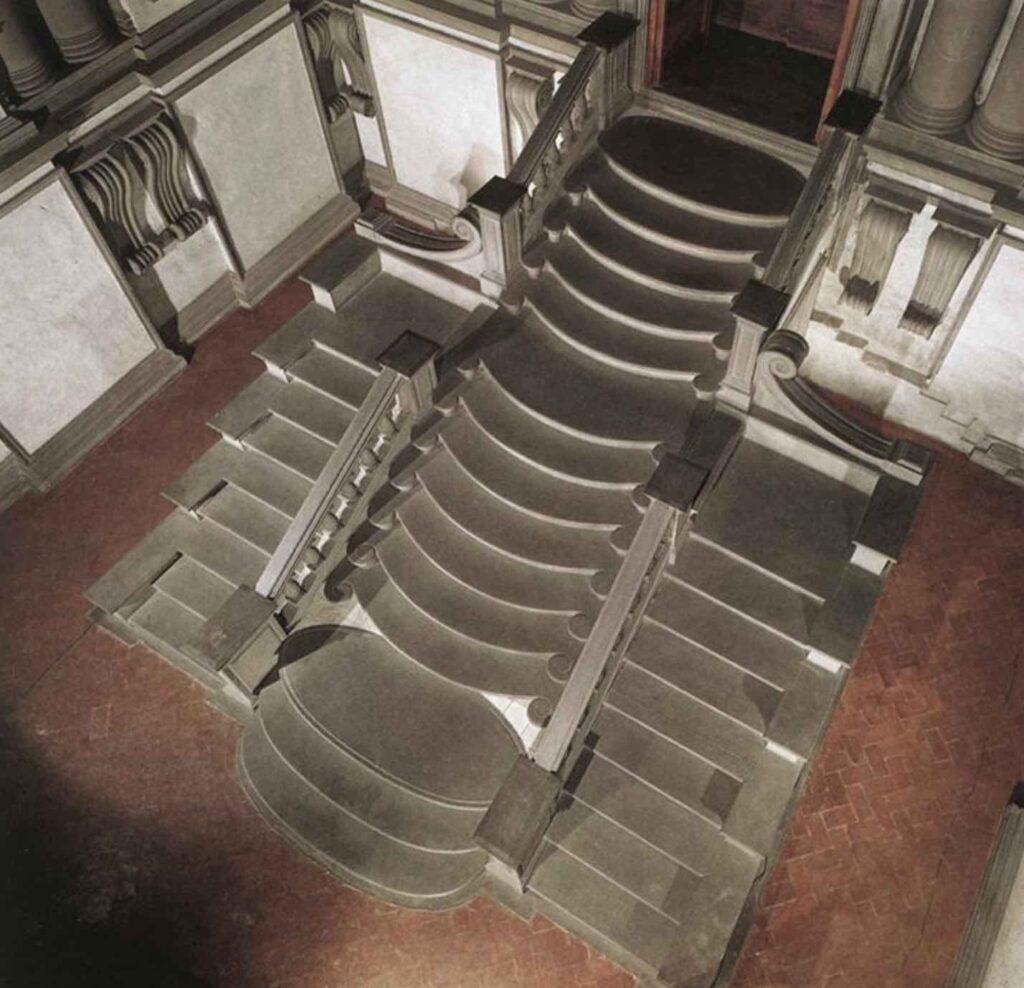
Situated in Florence’s San Lorenzo church, this library, designed by Michelangelo, is a prime example of Mannerist architecture. Its vestibule, staircase, and reading room showcase the artist’s revolutionary architectural concepts.
The Rondanini Pietà (1552-1564)
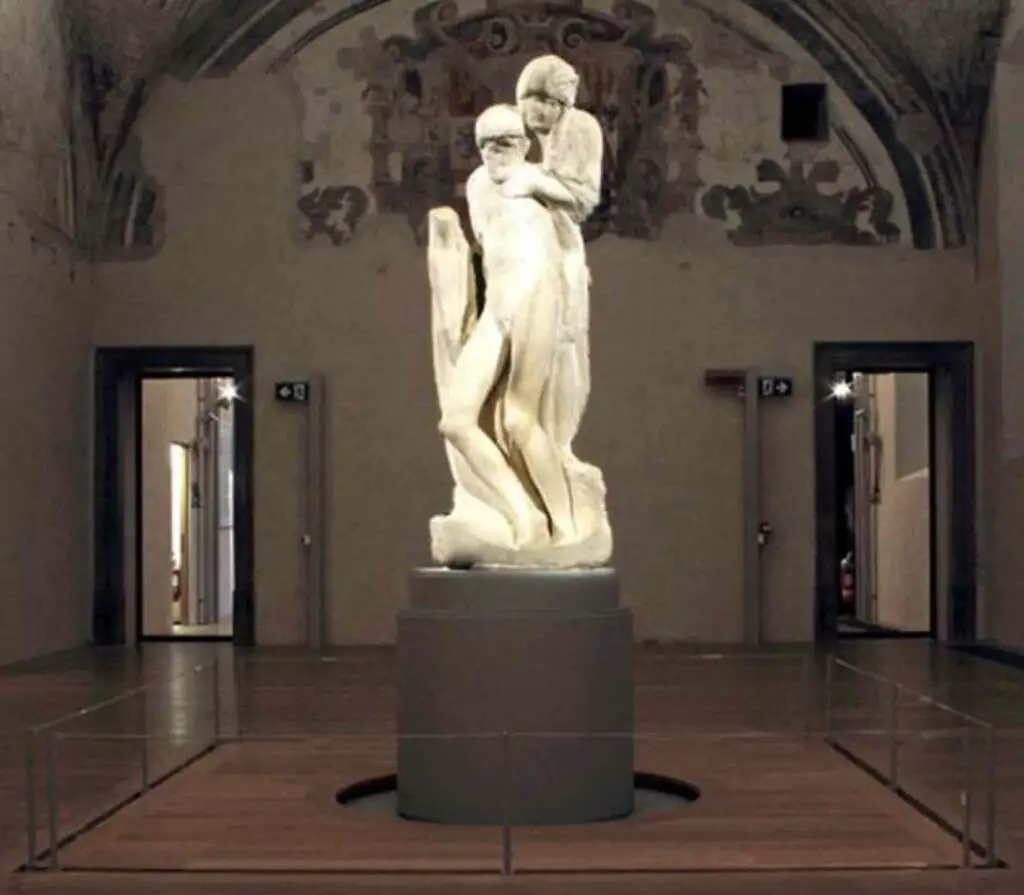
Michelangelo’s last sculpture, this Pietà, starkly contrasts his earlier version. It depicts a slender Virgin Mary with a gaunt Christ, reflecting the artist’s thoughts on mortality and redemption as he approaches his life’s end.
Michelangelo’s works are not just art pieces; they are a chronicle of a genius’s journey through life, marked by spiritual introspection, relentless passion, and unparalleled skill. Whether an art enthusiast or a casual observer, Michelangelo’s creations invite you to witness a blend of human emotion and divine inspiration captured in stone, paint, and architecture.
Michelangelo: The Timeless Luminary of Art
Michelangelo is, without a doubt, one of the most pivotal figures in the annals of art history. His prodigious talent, unyielding passion, and pioneering vision have immortalized him as a true titan in artistic expression. Born during a period of profound cultural and intellectual awakening—the Renaissance—Michelangelo’s life and work perfectly embody the spirit of this era.
The Renaissance, meaning ‘rebirth,’ marked a resurgence of interest in Ancient Greece and Rome’s classical art, literature, and wisdom. It was a time when artists, thinkers, and visionaries reimagined the potential of human creativity, breaking free from the shackles of medieval rigidity to explore realms of beauty, knowledge, and innovation.
Michelangelo was a beacon of this movement, influencing and being influenced by the zeitgeist of his time.
Here’s why Michelangelo stands tall, not just as a great Renaissance artist but as one of the greatest artists to have ever graced our world:
Versatility:
Michelangelo was not confined to a single medium or style. He was a master sculptor, painter, architect, and poet. His versatility is a testament to his inexhaustible creativity and ever-curious mind.
Iconic Creations:
Few artists have given the world as many iconic masterpieces as Michelangelo. From the celestial beauty of the Sistine Chapel ceiling to the imposing grandeur of the David statue, his works are not just art—they are timeless legends.
Depth of Expression:
Michelangelo’s works transcend mere aesthetic appeal. They delve deep into human emotion, spiritual quests, and existential contemplations. His Pietà isn’t just a sculpture; it’s a mother’s anguish, a son’s sacrifice, and a viewer’s introspection.
Pioneering Techniques:
While he revered classical traditions, Michelangelo was not afraid to innovate. His frescoes, sculptures, and architectural designs showcased groundbreaking techniques that inspired and challenged his contemporaries.
Legacy:
Centuries after his passing, Michelangelo’s influence is palpable. From art schools to museums, from academic discourses to pop culture references, the spirit of Michelangelo thrives, proving the timelessness of his creations.
To call Michelangelo “great” would be an understatement. He wasn’t just an artist but a phenomenon, a force of nature that reshaped the contours of art and aesthetics.
Through his works, he beckoned humanity to look beyond the mundane, seek beauty, confront truth, and aspire for the divine. Today, as we stand in awe before his masterpieces, we don’t just witness strokes, colors, or chiseled marble.
We encounter a soul that yearned, created, and transcended.
Anita Louise Art is dedicated to art education, great artists, and inspiring others to find and create their art. We love art that uplifts and inspires. #ArtToMakeYouSmile! #ArtToMakeYouHappy!
If you are interested to see any of my art, you can find out more by clicking here. If you are interested in what inspires me and my paintings, you can discover more by clicking here.
We have a free newsletter and would love you to be part of our community; you can subscribe to the newsletter by clicking here. If you have any questions, I would be happy to talk to you. You can reach me, Anita, by clicking here.
Subscribe to our Anita Louise Art YouTube Channel with great videos and information by clicking here.
Join us for our podcast “5 Minutes With Art.” Spend just 5 minutes a week with us to discover and learn about great art and artists. You can find out more about our podcast by clicking here.
Frequently Asked Questions
What are Michelangelo’s most famous works?
Michelangelo’s most renowned works include the Statue of David, the Sistine Chapel ceiling, and the Pietà. These masterpieces showcase his exceptional skill in sculpture and painting.
What is the significance of Michelangelo’s Statue of David?
The Statue of David is a symbol of human potential and perfection. Michelangelo’s depiction of David before facing Goliath emphasizes the strength, courage, and intellectual prowess of the human form.
How did Michelangelo approach his work on the Sistine Chapel ceiling?
Michelangelo painted the Sistine Chapel ceiling lying on his back, a remarkable feat considering the scale and complexity of the project. The ceiling features iconic scenes from the Bible, such as the Creation of Adam.
What inspired Michelangelo’s creation of the Pietà?
The Pietà, a sculpture of the Virgin Mary holding the lifeless body of Jesus, reflects Michelangelo’s deep religious devotion and his ability to convey profound emotions through marble. It is considered a masterpiece of Renaissance sculpture.
Why is Michelangelo considered a Renaissance artist?
Michelangelo is considered a Renaissance artist because he lived during the Renaissance period (14th to 17th century) and his works reflect the period’s emphasis on classical themes, humanism, and a renewed interest in the arts and sciences.
How did Michelangelo’s artistic style differ from his Renaissance peers?
Michelangelo’s style is characterized by a combination of classical influences, intense emotion, and a focus on the human body’s anatomical precision. His works often exude a sense of dynamic movement and powerful expression.
What challenges did Michelangelo face while creating his masterpieces?
Michelangelo faced various challenges, including physical hardships while working on the Sistine Chapel ceiling, artistic rivalries, and the pressure of meeting the high expectations of his patrons, such as the Medici family and the Catholic Church.
Did Michelangelo only work as a sculptor and painter?
While Michelangelo is most famous for his sculptures and paintings, he was also an accomplished architect. His architectural designs include the dome of St. Peter’s Basilica in Rome and the Laurentian Library in Florence.
How did Michelangelo’s work influence future generations of artists?
Michelangelo’s innovative approach to art and his emphasis on the mastery of the human form had a profound impact on later artists. His techniques and ideals influenced the development of Mannerism and Baroque art.
What is Michelangelo’s legacy in the art world?
Michelangelo’s legacy is enduring, as he is widely regarded as one of the greatest artists in history. His contributions to art, sculpture, and architecture continue to inspire and influence artists, scholars, and art enthusiasts worldwide.
Related Questions
Did Michelangelo And Leonardo Know Each Other?
Michelangelo and Leonardo da Vinci knew each other but were considered bitter rivals. Leonardo da Vinci and Michelangelo knew each other, but they did like each other. They were both asked to do a commission on the Council Hall of the Palazzo Vecchio and were supposed to work side-by-side; the project was never completed.
By clicking here, you can learn more by reading Did Michelangelo And Leonardo Know Each Other?.
Michelangelo’s Method To Paint The Sistine Chapel Ceiling
He built a large scaffolding structure that could move around the chapel to paint the ceiling; the painting of the Sistine Chapel was an extremely strenuous work that was a huge personal cost both physically and mentally to Michelangelo.
By clicking here, you can learn more by reading Michelangelo’s Method To Paint The Sistine Chapel Ceiling.
Michelangelo’s Sistine Chapel And His Payment
Michelangelo was paid 3200 gold ducats for his work on the ceiling of the Sistine Chapel, which would have been a very lucrative commission. We know that he stopped work on the ceiling for a while due to his not being paid by the Vatican. Michelangelo liked to give the impression that he was a very poor artist, but records have shown that he died an extremely wealthy man.
By clicking here, you can learn more by reading Michelangelo’s Sistine Chapel And His Payment.

